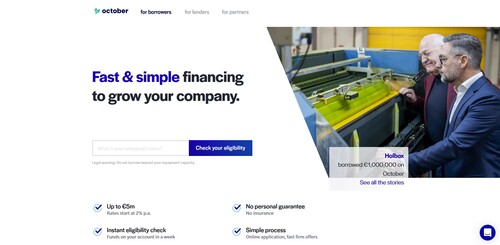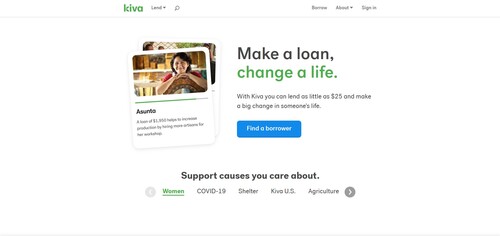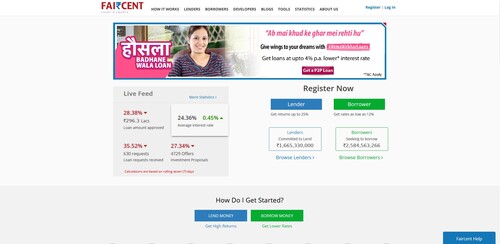P2P Lending | Regulating Peer-to-Peer Lending?
Peer-to-Peer lending platforms have so far welcomed regulation. By and large, regulation makes any market a little bit safer, granted, it's not always successfully done. Historically speaking, investment industries as well as foreign exchanges, have always been better off with a bit of regulation to ensure healthy investment ecosystems.
The question of how much regulation is appropriate, is a timeless debate between economic schools of thought, more specifically between John Keynes and Milton Friedman. Keynes believed that the free market could utilize government spending and handouts. Whereas, Milton Friedman believed that the free-market had the wherewithal to regulate itself.

But in our current society, more so if you live in the West, we tend to be in favor of having regulation. Some P2P lending platforms are regulated, including October, Kiva, and Faircent. Others are at various stages of the registration and regulation process. Investors feel better knowing that the platforms they are investing with are complying with the legal requirements necessary to be fully legitimate investing services.
Regulation, as it should be understood, is to ensure money is not mismanaged and there no malpractices on the side of the companies management.
Mintos
Boasting over 500,000 users and nearly 9 billion euro in funds invested, Mintos is one of the largest peer-to-peer lending and investment platforms in Europe. Mintos specializes in short-term consumer loans originated by a long list of European loan originators, including Eleving, Placet Group, Delfin Group, and Mikro Kapital. The platform is based in Latvia, and all its financial activities, which span much of Europe, are regulated by the Financial and Capital Market Comission (FCMC). Between 2021 and 2023, the Bank of Latvia (Latvijas Banka) was integrated into the FCMC, creating "one powerful and efficient institution," according to a 2022 press release from Latvijas Banka. FCMC and Latvijas Banka completed the integration in 2023.
Users can choose from three strategies: Mintos Core, Custom Automated, and Manual Investing. The Core plan is a portfolio built and managed by Mintos, and users who feel they can trust the platform are invited to invest as much as they'd like, with a minimum of only 10 euro. Core continues to reinvest your funds till you cash out, with the expected returns hovering around 11.5% per annum. The Custom Automated plan allows the user to define the terms of the portfolio using 15 investment criteria. Once activated, automated system manages the portfolio of behalf of the user.
The third approach is Manual Investing, which simply means the investor manages the portfolio on their own. This approach is the most flexible, but also requires the most time and attention, as there are nearly 15,000 sets of notes available on Mintos. It's rather obvious the Core plan requires the least amount of effort, and is best suited to beginners with insufficient training. The Custom strategy is best for investors with general understanding but limited time. In addition, the Mintos Core plan is the most stable, while the Interest Rates on the other two range from as little as 4% to as much as 21% per annum.
Iuvo Group
Iuvo Group was established in Estonia in 2016, with the aim of helping Europeans earn passive income via the purchase of loan notes, and to save money via a high-interest savings vehicle (IuvoSave). The platform has over 35,000 users, who have invested a combined €350 million euro. Iuvo has won several awards, including the Forbes Best Company for 2020 in the finance category. The platform reports an average annual return for investors of 9.2%, with a maximum interest rate of 15.22%. Iuvo-Group is regulated by the Estonian Financial Supervision and Resolution Authority (Finantsinspektsioon), which in turn reports to the European Single Supervisory Mechanism.
Iuvo offers two important services: an investment vehicle that allows users to purchase loan notes, and a high-yield savings vehicle that allows users to earn for interest on their savings than they could at any bank. The investment vehicle is similar to that of other platforms. Users can invest in loans for as little as €10 while paying zero fees on the primary market, and a mere 1% on the secondary market. Loans on the Iuvo marketplace range from as little as 100 euro to as much as 25,000, with the duration starting at 7 days and reaching as far as 60 months (5 years).
The IuvoSave plan helps users maximize the value of their savings by providing returns of 5 to 7% per annum, which is obviously much more than any bank will offer you. There are also special bonuses and increased rates for loyal investors. The first loyalty tier (or "Club") is the Silver Club, which offers deposit processing within 3 hours, a reduced fee for sales on the secondary market, and faster withdrawal times. The Gold Club offers even faster times, and zero fees on the secondary market. It also allows you to make twice as many investments per turn.
October
October, formerly known as Lendix, is a large player in the European peer-to-peer lending space. They fund SME's throughout Europe. The minimum investment entry on October is 20 EUR and October projects an average yearly return of 3 -7 percent.

Due to EU regulations that October complies with they are required to ensure their investors are informed of the risks involved with investing in Peer-to-Peer lending. Also due to regulation all customers are required to undertake thorough know-your-customer protocols.
SME's is short for small to medium sized enterprises, this means small businesses, small cafes, restaurants, independent clothe stores and the likes. Half of Europe's of economy is dependent on small to medium-sized enterprises and income they produce. In some sense, SME's are the heart of Europe's economy and culture. October is backed and supported by the European Union. And it lends capital only to projects in the European Union. October itself is in many ways a European project for Europeans to invest in.
Kiva
Kiva is an American peer-to-peer lending platform aimed of curing the world of poverty. Investing on Kiva will reap no returns. Kiva is a purely philanthropic venture for investors. Whereby, investors can invest at minimum 25 USD to limited income individuals with dreams to improve the lives for themselves and those around them.

Kiva reports a low default rate of 6 percent so investors can rest assured their money will not only help those in need but come back to them. In this case, Kiva suggests reinvesting the same 25 USD, so you, as an investor with only 25 dollars can impact multiple people over the years.
Some of the borrowers on Kiva live under 2 dollars a day, so 25 dollars can mean a lot of improvement and opportunity for these borrowers. Kiva is always looking for ways to expand their services to those who have limited income or are struggling with severe financial stress. The concept with which Kiva was developed is not only incredibly noble, but also showcases the utility that P2P lending has for sustainable methods of decreasing levels of poverty around the world.
Kiva as an approach to business embodies the old quote, "Give a man a fish and you feed him for a day, teach him how to fish and feed him for the rest of his life".
Faircent
Faircent is an Indian peer-to-peer lending platform that is regulated by the national reserve bank of India. Faircent is different from its international counterpart in that the lending market is less forgiving of less seasoned investors. Minimum investment entry is 50,000 rupees or 680 USD. Average yearly return ranges from 10 - 13 percent, if borrowers commit to their loan contracts.

If a borrower defaults on Faircent then the investor simply loses his or her money. Fund recovery with Faircent has historically not been effective. To either borrow or invest with Faircent is quite an ordeal. In order to invest with them one must be a well-to-do individual with a job, be educated, and all of which must be proven through documents. Faircent requires a long list of identification details as per the rules of their regulatory framework.
Though the return on Faircent is rather high it does come with a lot of risk. All loans issued are unsecured consumer loans which tend to have a chance of defaulting. There is also no buyback guarantee. The platform offers no assistance in the case of a loss on their platform.

Market Type
Consumer Loans
Average Returns
9 - 12%
Minimum Investment
EUR 10
Signup Bonus
1%
Registered users
500,000
Total funds invested
EUR 8.9 Billion
Default rate
16%
Regulating entity
Financial & Capital Market Comission (Latvia)
Buyback guarantee
Secondary market
Payment methods
PayPal, Bank Transfer, Credit Card, TransferWise
Withdrawal methods
Wire transfer, Credit Card
Mintos is P2P loan originator aggregator whom after years of slow growth exploded and became the number one P2P lending platform in Europe. Find out why in this review. Is Mintos an investment worth considering?

Market Type
Consumer Loans
Average Returns
8 - 10%
Minimum Investment
EUR 10
Signup Bonus
None
Registered users
36,000
Total funds invested
EUR 370 Million
Default rate
8%
Regulating entity
Estonian Financial Supervision Authority
Buyback guarantee
Secondary market
Payment methods
Bank Transfer, Trustly, Paysera, Revolut, TransferWise, ePay
Withdrawal methods
Bank Transfer
Iuvo is an award-winning P2P and personal-savings platform based in the Republic of Estonia and regulated by the Estonian Financial Supervision and Resolution Authority. The platform is well-funded, and works with several loan originators to market personal loans ranging from 1000 to 2500 EUR.

Market Type
Business Loans
Average Returns
3 - 7%
Minimum Investment
EUR 20
Signup Bonus
EUR 20
Registered users
43,000
Total funds invested
EUR 1 Billion
Default rate
3%
Regulating entity
Self-Regulated/EU Compliant
Buyback guarantee
Secondary market
Payment methods
Bank Card, Bank Transfer, TransferWise
Withdrawal methods
Bank Card, Bank Transfer, TransferWise
October specializes in small risk business loans specifically to SME's in Europe. October has a great track record of fund recoveries, a solid mission and a very strong foundation. October's business and risk strategy is worth the time to read.

Market Type
Charitable Loans
Average Returns
0%
Minimum Investment
USD 50
Signup Bonus
USD 25
Registered users
40,000
Total funds invested
USD 1.68 Billion
Default rate
4%
Regulating entity
Self-Regulated/SEC Compliant
Buyback guarantee
Secondary market
Payment methods
Bank Transfer, Credit Card, Debit Card
Withdrawal methods
Bank Transfer, Credit Card, Debit Card
Kiva is a P2P lending platorm built to help low income families find a consistent cash flow to survive. Lenders take no interest on the credit they provide but have the ability to lend out the same capital to multiple borrowers.

Market Type
Consumer Loans
Average Returns
8 - 25%
Minimum Investment
INR 50,000
Signup Bonus
None
Registered users
250,000
Total funds invested
INR 32.34 Billion
Default rate
7 %
Regulating entity
Reserve Bank of India
Buyback guarantee
Secondary market
Payment methods
Bank Card, Bank Transfer
Withdrawal methods
Bank Card, Bank Transfer
Faircent is only available to Indian residents and citizens. Faircent offers very high returns and a proven method of making investors profitable. Faircent is one of the few P2P lending platforms around the world to be fully regulated and compliant with all of their legal obligations.
Pros of Regulation
Regulation is necessary for multiple reasons, the first reason being to serve as a bulwark against the power of monopolies. Having too much decision making power in the hands of a few ultimately produces undesirable results.
The reason is because if one entity manages all of the lending market and they make a mistake then the outcome would be catastrophic. Similar to why investors often advise to diversify portfolios, it's never good to have all your eggs in one basket. Regulation also ensures there is a certain degree of fairness within any marketplace. In modern society, whether it's regulation in the food and drug industry or regulation in the banking and private sector, regulation has made an improvement in the current societal infrastructure that we use today. This is because regulation and oversight can fight against forms of discrimination, bias and corruption.
Sometimes regulation occurs out of necessity. After the 2008 financial real estate crash, many banks were required to do more rigorous credit checks and be less lenient of issuing loans to borrowers for property. This regulation was necessary because of the malpractice on the side of the banks but it may have been too much regulation in retrospect.
Cons of Regulation
There can always be a problem with too much regulation or rather, too much bureaucracy. Governments sometimes have demands that require time and resources from the company, in turn, meaning more expenses.
When there is more expenses on Peer-to-Peer lending platforms, the platforms are not the ones that pay. The investors pay the fees, meaning higher fees on marketplace transactions and less overall profit.
Regulation can be either good or bad. The primary the question should be: is it necessary? If platforms and companies were able to achieve a safe incorruptible lending environment, then government regulation would just be a waste of money and unrealized profits.
Appropriate Regulation
Regulation should only exist to ensure the validity and authenticity of peer-to-peer lending platforms. The government in any given nation has no right to determine who is eligible for a loan and who is not.
As that was the initial problem, the banks were determining who could and could not borrow. P2P lending is the outcome of over-regulation. One of the reasons peer-to-peer lending is such a success is because the banks as they are in our modern day will not just provide anyone with a loan, even if they have an income. If the borrowers on P2P lending were regulated by the government it would defeat the purpose of Peer-to-Peer lending which is definitely something worth considering.
Verdict
Alternative finance emerged as a response to regulating becoming a serious problem. Alternative finance exists because it takes a chance on those borrowers who are high risk and generally disregarded by regulations. This is possible solely to the fact that microfinancing borrowers is a plausible investment decision. Unfortunately, the cost and pressure associated with complying to regulations might even put a financial strain on these platforms. As we endure through this nascent phase of P2P lending it is likely we will find the best solution for regulation and Peer-to-Peer lending.
There is certainly a need for the state or legislature to ensure that certain practices are kept. To ensure that investors are as safe on these platforms as they are on any other investment platform. If we understand that regulation can be detrimental to the profitability of a platform then we might ask ourselves, how do we go about ensuring appropriate regulation? Some regulated platforms already exist and many others are attempting to receive international accreditation as well, from their respective financial institutions.
Peer-to-Peer lending platform Mintos is fully regulated and EU compliant. It's an excellent p2p lending platform, with a good track record of returns. The Mintos marketplace is brimming with loan offers large and small, and via careful investing, users can enjoy returns of up to 12% per annum.



